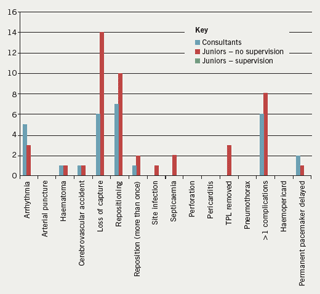As the number of temporary pacing lead insertions performed declines, the experiential competency of physicians can also be expected to fall. We performed a retrospective study looking at the route of insertion, indications and complications comparing consultants and junior doctors.
Introduction
Some studies have stated that the responsibility for implanting temporary pacing wires should be taken away from general physicians and have recommended that junior staff should always be supervised by a cardiologist.1,2
Patients and methods
A retrospective review of hospital records of patients receiving a temporary pacemaker at National Health Service (NHS) Lanarkshire hospitals over a two-year period was undertaken (between 30/04/2005 to 30/04/2007). Data were collected to yield information broadly comparable to three similar previous studies.2-4 Adequate records were obtained for 100 procedures.
A questionnaire was formulated and sent to junior doctors to assess their competency in inserting temporary pacing wires and whether there was a deficiency of teaching in this area.
Independent sample t-test was carried out. A p value of <0.05 was considered significant.
Results
A total of 100 procedures were performed on 100 patients. The primary indication for pacing was second/third degree heart block with haemodynamic compromise or syncope at rest in 30% of the patients; symptomatic bradycardia (not associated with myocardial infarction) was the indication in 14%; asystole (not associated with myocardial infarction) was the indication in 12%; ventricular tachycardia (VT) secondary to bradycardia was the indication in 12%; coronary angiogram was the indication in 11%; all the other indications were less common.
Training grades (that is, non-consultant or non-staff-grade physicians) performed 47 cases (47%). Consultant or staff-grade physicians performed 47 cases (47%) and, out of these, four cases were performed by staff grades. Six procedures had to be excluded from the study as it was unknown who had performed the case.
The right femoral vein was first choice for venous access in 55% of the cases. The right internal jugular vein was the route in 37%. All the other routes were less commonly used.
The results of a questionnaire regarding temporary pacing leads (TPLs) were as follows:
- Most senior house officers (SHOs)/junior specialist registrars (SpRs) had not had any training in inserting TPLs and, in fact, most had not had any opportunity to insert TPLs.
- All SHOs/SpRs felt there was a lack of training in this area.
Complications
The majority of immediate complications were arrhythmias. There were three cerebrovascular accidents.

The most common late complication was loss of capture, which occurred 24 times in 24 different patients. In 21% of the patients, repositioning was required. Repositioning was required among insertions performed by junior staff 13 times. In the consultant category, repositioning was required seven times. Other complications such as site infection and septicaemia occurred at lower rates.
In 58% of the cases, no complications occurred. When staff grades or consultants were present, complications occurred in 33% of the patients, whereas when junior staff carried out the procedure, complications occurred in 50%
(figure 1).
Conclusion
Temporary pacemaker procedures are still performed by physicians with variable
experience and training, and are associated with a higher incidence of loss
of capture among juniors compared with consultants.
Conflict of interest
None declared.
Editors’ note
See also Editorial by Artis et al. on pages 11–12 and paper by Barron et al. on pages 32–3.
Recommendations
- All temporary pacing leads (TPLs) should be inserted by experienced staff such as cardiology consultants/specialist registrars
- Adequate training should be provided for junior staff, which will allow them to insert TPLs safely
Key messages
- There is a higher incidence of loss of capture among insertions performed by juniors compared with consultants
- Junior staff feel that there is a lack of training in this area
References
- Petch MC. Temporary cardiac pacing. Postgrad Med J 1999;75:577.
- Brown A, Thwaites B. Complications associated with 64 temporary pacing wires implanted at a district general hospital – should this procedure be reserved for specialist centres? Br J Cardiol 2002;9:339–42.
- Murphy JJ. Current practice and complications of temporary transvenous cardiac pacing. BMJ 1996;312:1134.
- Winner SJ, Boon NA. Clinical problems with temporary pacemakers prior to permanent pacing. J Roy Coll Phys (Lond) 1989;23:161–3.
